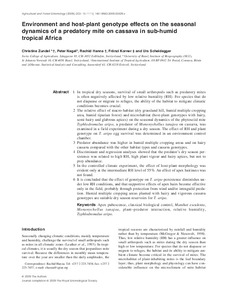| dc.contributor.author | Zundel, C. |
| dc.contributor.author | Nagel, P. |
| dc.contributor.author | Hanna, R. |
| dc.contributor.author | Korner, F. |
| dc.contributor.author | Scheidegger, Urs C. |
| dc.date.accessioned | 2019-12-04T11:11:38Z |
| dc.date.available | 2019-12-04T11:11:38Z |
| dc.date.issued | 2009 |
| dc.identifier.citation | Zundel, C., Nagel, P., Hanna, R., Korner, F. & Scheidegger, U. (2009). Environment and host‐plant genotype effects on the seasonal dynamics of a predatory mite on cassava in sub‐humid tropical Africa. Agricultural and Forest Entomology, 11(3), 321-331. |
| dc.identifier.issn | 1461-9555 |
| dc.identifier.uri | https://hdl.handle.net/20.500.12478/2470 |
| dc.description.abstract | In tropical dry seasons, survival of small arthropods such as predatory mites is often negatively affected by low relative humidity (RH). For species that do not diapause or migrate to refuges, the ability of the habitat to mitigate climatic conditions becomes crucial. 2 The relative effect of macro-habitat (dry grassland hill, humid multiple cropping area, humid riparian forest) and microhabitat (host-plant genotypes with hairy, semi-hairy and glabrous apices) on the seasonal dynamics of the phytoseiid mite Typhlodromalus aripo , a predator of Mononychellus tanajoa on cassava, was examined in a field experiment during a dry season. The effect of RH and plant genotype on T. aripo egg survival was determined in an environment control chamber. 3 Predator abundance was higher in humid multiple cropping areas and on hairy cassava compared with the other habitat types and cassava genotypes. 4 Discriminant and regression analyses showed that the predator’s dry season per-sistence was related to high RH, high plant vigour and hairy apices, but not to prey abundance. 5 In the controlled climate experiment, the effect of host-plant morphology was evident only at the intermediate RH level of 55%. An effect of apex hairiness was not found. 6 It is concluded that the effect of genotype on T. aripo persistence diminishes un-der low RH conditions, and that supportive effects of apex hairs become effective only in the field, probably through protection from wind and/or intraguild preda-tion. Humid multiple cropping areas planted with hairy and vigorous cassava genotypes are suitable dry season reservoirs for T. aripo . |
| dc.description.sponsorship | Swiss Agency for Development and Cooperation |
| dc.description.sponsorship | International Fund for Agricultural Development |
| dc.format.extent | 321-331 |
| dc.language.iso | en |
| dc.subject | Apex Pubescence |
| dc.subject | Classical Biological Control |
| dc.subject | Manihot Esculenta |
| dc.subject | Mononychellus Tanajoa |
| dc.subject | Plant – Predator Interaction |
| dc.subject | Relative Humidity |
| dc.subject | Typhlodromalus Aripo |
| dc.subject | Morphology |
| dc.subject | Neotropical |
| dc.title | Environment and hostplant genotype effects on the seasonal dynamics of a predatory mite on cassava in subhumid tropical Africa |
| dc.type | Journal Article |
| dc.description.version | Peer Review |
| cg.contributor.affiliation | Swiss College of Agriculture |
| cg.contributor.affiliation | University of Basel |
| cg.contributor.affiliation | International Institute of Tropical Agriculture |
| cg.contributor.affiliation | Statistical Analysis and Consulting |
| cg.coverage.region | Acp |
| cg.coverage.region | Africa |
| cg.coverage.region | Europe |
| cg.coverage.region | West Africa |
| cg.coverage.country | Switzerland |
| cg.coverage.country | Benin |
| cg.isijournal | ISI Journal |
| cg.authorship.types | CGIAR and advanced research institute |
| cg.iitasubject | Cassava |
| cg.iitasubject | Disease Control |
| cg.iitasubject | Farm Management |
| cg.iitasubject | Genetic Improvement |
| cg.iitasubject | Plant Breeding |
| cg.iitasubject | Plant Genetic Resources |
| cg.iitasubject | Plant Production |
| cg.journal | Agricultural and Forest Entomology |
| cg.howpublished | Formally Published |
| cg.accessibilitystatus | Limited Access |
| local.dspaceid | 93221 |
| cg.identifier.doi | https://dx.doi.org/10.1111/j.1461-9563.2009.00429.x |

